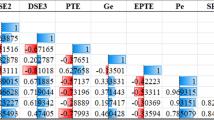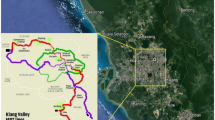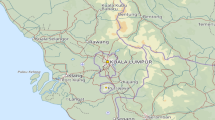Abstract
The primary determinant in pile foundation design is the pile-bearing capacity (PBC), which relies on various soil characteristics and multiple parameters related to both soil and foundation. Accurately predicting PBC is crucial for structural safety, but traditional estimation methods often lack precision due to oversimplified assumptions. In response to this challenge, Machine Learning (ML) models have become formidable tools with sophisticated algorithms and extensive datasets. This research aims to develop predictive ML models using the Least Square Support Vector Regression (LSSVR) technique to estimate the PBC. These predictive models were developed by integrating LSSVR with optimization algorithms such as Prairie Dog Optimization (PDO) and Aquila Optimizer (AO), resulting in the LSSVR + PDO (LSPD) and LSSVR + AO (LSAO) models. A comprehensive database, including diverse pile characteristics and soil attributes obtained from literature sources, was employed to train and validate these models. The modeling results indicated that the LSPD model exhibited superior performance in terms of accuracy and reliability compared to the LSAO and LSSV models. It demonstrated a substantial improvement, with a 0.6% and 2% increase in R2 and a notable decrease of 19.6% and 42.3% in RMSE compared to LSAO and LSSV, respectively.






Similar content being viewed by others
Data availability
The data required for these findings will be available upon request.
References
Abualigah L et al (2021) Aquila optimizer: a novel meta-heuristic optimization algorithm. Comput Ind Eng 157:107250
Abu-Farsakh MY, Titi HH (2004) Assessment of direct cone penetration test methods for predicting the ultimate capacity of friction driven piles. J Geotech Geoenviron Eng 130(9):935–944
Adeli H (2001) Neural networks in civil engineering: 1989–2000. Comput-Aided Civ Infrastruct Eng 16(2):126–142
Aiyer BG et al (2014) Prediction of compressive strength of self-compacting concrete using least square support vector machine and relevance vector machine. KSCE J Civ Eng 18(6):1753–1758
Akbarzadeh MR et al (2023) Estimating compressive strength of concrete using neural electromagnetic field optimization. Materials 16(11):4200
Alkroosh IS et al (2015) Regressive approach for predicting bearing capacity of bored piles from cone penetration test data. J Rock Mech Geotech Eng 7(5):584–592
AlRassas AM et al (2021) Optimized ANFIS model using Aquila optimizer for oil production forecasting. Processes 9(7):1194
Alzabeebee S (2022) Explicit soft computing model to predict the undrained bearing capacity of footing resting on aggregate pier reinforced cohesive ground. Innov Infrastruct Solut 7(1):105
Alzabeebee S, Chapman DN (2020) Evolutionary computing to determine the skin friction capacity of piles embedded in clay and evaluation of the available analytical methods. Transp Geotech 24:100372
Alzabeebee S, Alshkane YMA, Keawsawasvong S (2023) New model to predict bearing capacity of shallow foundations resting on cohesionless soil. Geotech Geol Eng 41(6):3531–3547
Ayubi Rad M, Ayubirad MS (2017) Comparison of artificial neural network and coupled simulated annealing based least square support vector regression models for prediction of compressive strength of high-performance concrete. Sci Iran 24(2):487–496
Benali A, Nechnech A, Bouafia A (2013) Bored pile capacity by direct SPT methods applied to 40 case histories. Civ Environ Res 5:118–122
Botchkarev A (2018) Performance metrics (error measures) in machine learning regression, forecasting and prognostics: properties and typology, ar**v preprint ar**v:1809.03006 [Preprint]
Briaud J-L (1988) Evaluation of cone penetration test methods using 98 pile load tests. In: International Symposium on penetration testing; ISOPT-1. 1, pp 687–697
Cai G et al (2009) Assessment of direct CPT and CPTU methods for predicting the ultimate bearing capacity of single piles. Eng Geol 104(3–4):211–222
Dehghanbanadaki A et al (2021) Estimation of ultimate bearing capacity of driven piles in c-$φ$ soil using MLP-GWO and ANFIS-GWO models: a comparative study. Soft Comput 25:4103–4119
Eslami A (1997) Bearing capacity of piles from cone penetration test data. University of Ottawa, Canada
Ezugwu AE et al (2022) Prairie dog optimization algorithm. Neural Comput Appl 34(22):20017–20065
Goh ATC (1995) Back-propagation neural networks for modeling complex systems. Artif Intell Eng 9(3):143–151
Goh ATC, Kulhawy FH, Chua CG (2005) Bayesian neural network analysis of undrained side resistance of drilled shafts. J Geotech Geoenviron Eng 131(1):84–93
Harandizadeh H, Jahed Armaghani D, Khari M (2021) A new development of ANFIS–GMDH optimized by PSO to predict pile bearing capacity based on experimental datasets. Eng Comput 37:685–700
Hiena TT et al (2023) XGBoost regression for estimating bearing capacity of concrete piles, 58, pp 3–11
Hoang N-D, Tran X-L, Huynh T-C (2022) Prediction of pile bearing capacity using opposition-based differential flower pollination-optimized least squares support vector regression (ODFP-LSSVR). Adv Civ Eng. https://doi.org/10.1155/2022/7183700
Hoogland JL (1995) The black-tailed prairie dog: social life of a burrowing mammal. University of Chicago Press
Hossain D, Capi G, **dai M (2018) Optimizing deep learning parameters using genetic algorithm for object recognition and robot gras**. J Electron Sci Technol 16(1):11–15
Hsu C-W, Chang C-C, Lin C-J (2003) A practical guide to support vector classification. Taipei, Taiwan
Kardani N et al (2020) Estimation of bearing capacity of piles in cohesionless soil using optimised machine learning approaches. Geotech Geol Eng 38(2):2271–2291. https://doi.org/10.1007/s10706-019-01085-8
Khajeh A et al (2021) Effect of EPS beads in lightening a typical zeolite and cement-treated sand. Bull Eng Geol Environ 80(11):8615–8632. https://doi.org/10.1007/s10064-021-02458-1
Khari M et al (2019) Computational estimation of lateral pile displacement in layered sand using experimental data. Measurement 146:110–118
Kiefa MAA (1998) General regression neural networks for driven piles in cohesionless soils. J Geotech Geoenviron Eng 124(12):1177–1185
Lee I-M, Lee J-H (1996) Prediction of pile bearing capacity using artificial neural networks. Comput Geotech 18(3):189–200
Milad F et al (2015) New method for predicting the ultimate bearing capacity of driven piles by using Flap number. KSCE J Civ Eng 19:611–620
Momeni E et al (2014) Prediction of pile bearing capacity using a hybrid genetic algorithm-based ANN. Measurement 57:122–131
Momeni E et al (2015) Application of artificial neural network for predicting shaft and tip resistances of concrete piles. Earth Sci Res J 19(1):85–93
Nawari NO, Liang R, Nusairat J (1999) Artificial intelligence techniques for the design and analysis of deep foundations. Electron J Geotech Eng 4(2):1–21
Ngoc-Nguyen L et al (2023) A practical review of prairie dog optimization algorithm in solving damage identification problems in engineering structures. In: Proceedings of the International Conference of Steel and Composite for Engineering Structures: ICSCES 2022. Springer. pp 296–306
Nhu V-H et al (2020) A hybrid computational intelligence approach for predicting soil shear strength for urban housing construction: a case study at Vinhomes Imperia project, Hai Phong city (Vietnam). Eng Comput 36(2):603–616
Okkan U, Serbes ZA (2012) Rainfall–runoff modeling using least squares support vector machines. Environmetrics 23(6):549–564
Ozturk B, Kodsy A, Iskander M (2023) Forecasting the capacity of open-ended pipe piles using machine learning. Infrastructures 8(1):12
Park J (2017) A comparative study on the bearing capacity of dynamic load test and static load test of PHC bored Pile. J Korean Geo-Environ Soc 18(9):19–31
Pham QB et al (2019) Combing random forest and least square support vector regression for improving extreme rainfall downscaling. Water 11(3):451
Pham BT et al (2020) A novel hybrid soft computing model using random forest and particle swarm optimization for estimation of undrained shear strength of soil. Sustainability 12(6):2218
Pham K et al (2021) Ensemble learning-based classification models for slope stability analysis. CATENA 196:104886
Robertson PK et al (1988) Axial capacity of driven piles in deltaic soils using CPT. In: International Symposium on penetration testing; ISOPT-1. 1, pp 919–927
Sedaghat B, Tejani GG, Kumar S (2023) Predict the maximum dry density of soil based on individual and hybrid methods of machine learning. Adv Eng Intell Syst. https://doi.org/10.22034/aeis.2023.414188.1129
Shahin MA (2010) Intelligent computing for modeling axial capacity of pile foundations. Can Geotech J 47(2):230–243
Shahin MA (2014) Load–settlement modeling of axially loaded steel driven piles using CPT-based recurrent neural networks. Soils Found 54(3):515–522
Shahin MA (2016) State-of-the-art review of some artificial intelligence applications in pile foundations. Geosci Front 7(1):33–44
Shahin MA, Jaksa MB (2005) Neural network prediction of pullout capacity of marquee ground anchors. Comput Geotech 32(3):153–163
Shaik S et al (2019) Applying several soft computing techniques for prediction of bearing capacity of driven piles. Eng Comput 35:1463–1474
Tarawneh B (2013) Pipe pile setup: database and prediction model using artificial neural network. Soils Found 53(4):607–615
Tavana Amlashi A et al (2023) Estimation of the compressive strength of green concretes containing rice husk ash: a comparison of different machine learning approaches. Eur J Environ Civ Eng 27(2):961–983. https://doi.org/10.1080/19648189.2022.2068657
Vapnik VN (1995) The nature of statistical learning. Theory [Preprint]
Wei Y et al (2020) Evaluation of ultimate bearing capacity of pre-stressed high-strength concrete pipe pile embedded in saturated sandy soil based on in-situ test. Appl Sci 10(18):6269
Yang X-S, Deb S (2009) Cuckoo search via Lévy flights. In: 2009 World congress on nature & biologically inspired computing (NaBIC). IEEE. pp 210–214
Author information
Authors and Affiliations
Contributions
XY: writing—original draft preparation, conceptualization, supervision, project administration.
Corresponding author
Ethics declarations
Conflict of interest
The authors declare no competing interests.
Additional information
Publisher's Note
Springer Nature remains neutral with regard to jurisdictional claims in published maps and institutional affiliations.
Rights and permissions
Springer Nature or its licensor (e.g. a society or other partner) holds exclusive rights to this article under a publishing agreement with the author(s) or other rightsholder(s); author self-archiving of the accepted manuscript version of this article is solely governed by the terms of such publishing agreement and applicable law.
About this article
Cite this article
Yang, X. Prediction of pile-bearing capacity using Least Square Support Vector Regression: individual and hybrid models development. Multiscale and Multidiscip. Model. Exp. and Des. (2024). https://doi.org/10.1007/s41939-023-00357-4
Received:
Accepted:
Published:
DOI: https://doi.org/10.1007/s41939-023-00357-4




